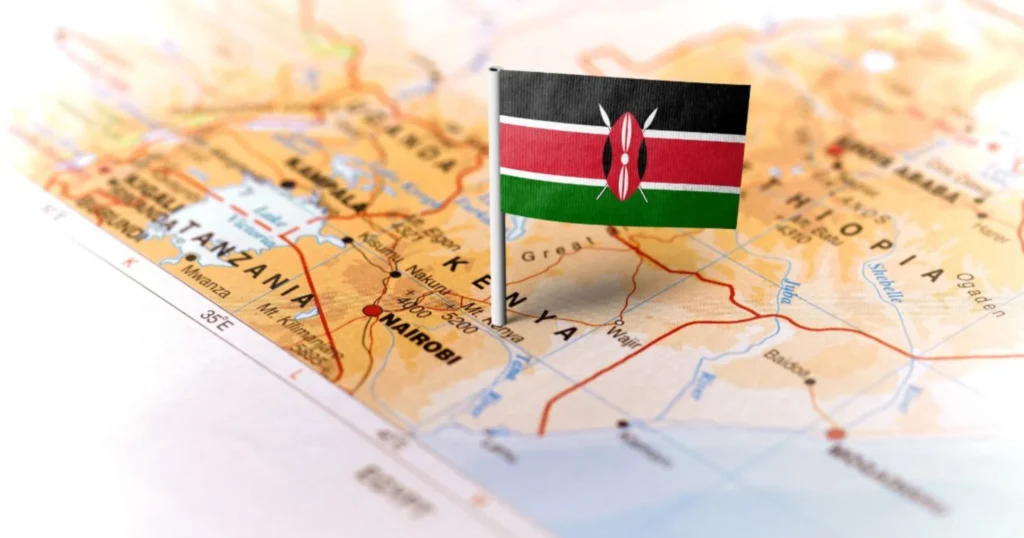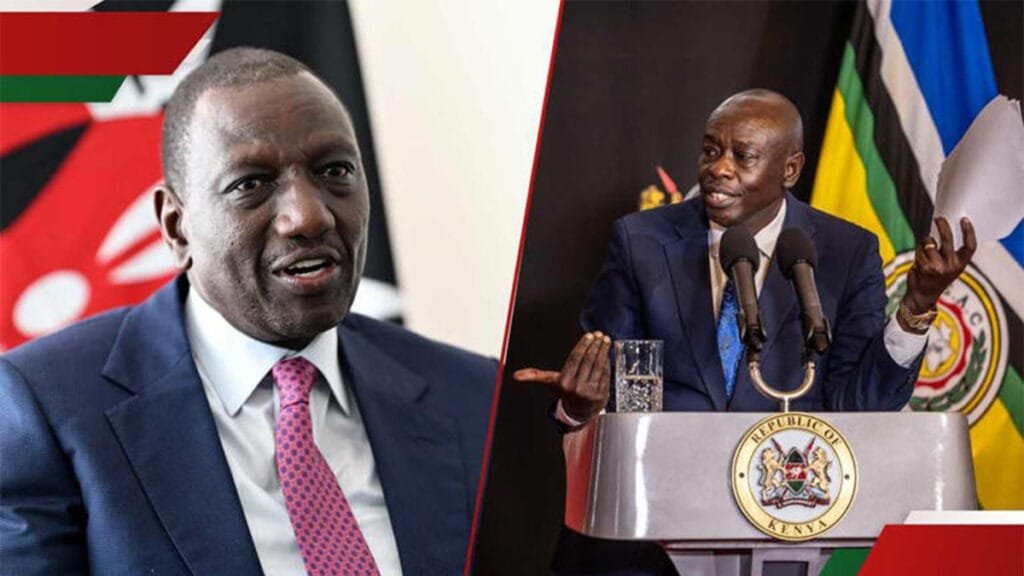Kenya’s economic ship is sailing through stormy waters as the government slashes its tax revenue targets for the second time in less than a year. The decision, announced in April 2025, underscores the mounting fiscal strain caused by months of political unrest, deadly protests, and a sluggish economic environment.
The revised tax collection target for the 2024/2025 fiscal year now stands at KSh 2.4 trillion (approximately $18.5 billion), down 3% from the already adjusted goal of KSh 2.475 trillion. The pressure to revise expectations came after the Kenya Revenue Authority (KRA) failed to meet its targets, collecting only about 66% of the revised revenue in the first nine months of the fiscal year. These shortfalls have had cascading effects across government operations, with budget constraints already being felt in sectors such as healthcare, education, and infrastructure.
Treasury Secretary John Mbadi emphasized that the protests, which at one point brought the economy to a virtual halt, were a primary factor behind the revenue underperformance. “This economy was shut for two months,” Mbadi told lawmakers. “That affected revenue collection significantly.”
But the broader issue extends beyond just a drop in tax revenue. Kenya’s economic model, heavily reliant on debt and external financing, is showing signs of deep stress. The country’s growing debt burden, now nearing unsustainable levels, has become a focal point of concern for economists, policymakers, and international institutions like the International Monetary Fund (IMF).
Protests and Policy Reversals Shake the Economy
At the heart of this fiscal backslide are the widespread protests that erupted after the government proposed a controversial Finance Bill. The bill introduced new taxes on essential goods such as bread, diapers, and fuel—items that hit the poorest households the hardest. Public anger erupted into full-blown demonstrations across major cities, with violent clashes resulting in the deaths of at least 60 people, according to human rights groups.
The protests, largely youth-led and fueled by social media campaigns, forced President William Ruto to abandon the proposed tax hikes. While this move was widely welcomed by the public, it left a gaping hole in the government’s budget strategy. The withdrawal of the Finance Bill cost the government nearly KSh 300 billion in expected revenue, further widening the budget deficit.
The violence and unrest also disrupted businesses and supply chains, reducing overall economic activity. Retail sales dropped, services stalled, and investor confidence took a hit. Economists say that even if the government had held on to the tax measures, it would have faced difficulty collecting them due to the fractured state of the economy.
President Ruto, elected on a platform of economic revival and “bottom-up” development, now faces his toughest test. The administration’s promise to expand economic opportunities for ordinary Kenyans is being undermined by these fiscal challenges and the growing sense of disillusionment among the populace.
Borrowing to Fill the Gap: A Risky Balancing Act
With revenue expectations in decline and pressure mounting to fund ongoing government operations, the Treasury has turned to borrowing—both domestic and foreign—to bridge the deficit. According to the most recent Treasury estimates, net domestic borrowing will increase by 46% to reach KSh 597.2 billion, while foreign borrowing is expected to hit KSh 718.4 billion, an increase of about 20% from previous projections.
This borrowing binge is not without consequences. Kenya’s public debt currently stands at over KSh 11.5 trillion (approximately $88 billion), equivalent to over 70% of its GDP. The IMF has already classified Kenya as being at high risk of debt distress, warning that the country’s debt servicing obligations could crowd out essential public services.
Analysts are concerned that the increased reliance on borrowing may lead to a debt trap. Domestic borrowing could result in the government crowding out private sector investment, pushing interest rates higher. Meanwhile, foreign loans—especially those tied to commercial terms—may saddle the country with higher repayment risks due to exchange rate volatility and global interest rate hikes.
Kenya’s external debt servicing alone is projected to consume nearly 30% of its total revenue in 2025, a figure considered unsustainable by most fiscal standards. This trend could deepen inequality and slow down long-term development if not carefully managed.
Exit from IMF Program Raises Eyebrows
In a surprising twist, Kenya chose to exit the final assessment of its four-year Extended Credit Facility (ECF) program with the International Monetary Fund, forfeiting approximately $850 million in low-interest financing. While the government stated that it would instead apply for a new agreement better aligned with its current priorities, the move has raised eyebrows among economic observers.
The decision comes at a time when Kenya needs external support more than ever. The IMF program had been instrumental in anchoring fiscal reforms and providing much-needed budgetary support. Exiting prematurely signals uncertainty in the country’s commitment to fiscal discipline and reform implementation.
Some analysts view the withdrawal as a reaction to growing domestic resistance against IMF-backed austerity measures, particularly tax reforms and subsidy cuts. However, critics argue that walking away from the deal could hurt Kenya’s credibility in the eyes of international markets and donors.
Without IMF support, Kenya may face tougher conditions when seeking external financing. Credit rating agencies have already taken note. Fitch Ratings downgraded Kenya’s long-term issuer rating from ‘B’ to ‘B-’, citing “worsened fiscal metrics” and growing uncertainties around revenue collection and public debt dynamics.
Fallout on Investors and the Private Sector
The economic turbulence in Kenya is also having repercussions in the private sector. Businesses are reporting a decline in consumer spending, while multinational firms are delaying investment decisions due to political instability and policy unpredictability. The Nairobi Securities Exchange (NSE) has experienced increased volatility, and the Kenya Shilling continues to face pressure against the US Dollar.
Small and Medium Enterprises (SMEs), the backbone of Kenya’s economy, have been especially hard-hit. With banks tightening credit and demand for goods declining, many SMEs are struggling to stay afloat. A slowdown in government payments to contractors—driven by revenue shortfalls—has further strained liquidity across industries.
Meanwhile, inflation has remained persistently high, hovering around 7.8% as of March 2025. Food and fuel prices have been particularly volatile, eroding purchasing power and amplifying social discontent.
Foreign investors, once optimistic about Kenya’s growth potential, are adopting a wait-and-see approach. The country’s Eurobond-yields have surged, reflecting increased risk perceptions. If these trends continue, Kenya may face higher borrowing costs that could further strain its already fragile fiscal position.
Finding a Sustainable Path
Kenya now finds itself at a crossroads. The government must strike a careful balance between fiscal consolidation and economic inclusivity. Slashing tax targets may have been politically expedient in the short term, but it has also highlighted the urgent need for a more comprehensive and sustainable economic strategy.
Experts argue that Kenya must focus on broadening its tax base rather than introducing new taxes on essential goods. Improving tax compliance, digitizing tax administration, and tackling corruption at revenue collection points could yield substantial gains without causing undue hardship to the population.
On the expenditure side, there’s a call for increased fiscal transparency and prioritization of key sectors such as healthcare, education, and infrastructure. Reducing wasteful spending, particularly in government salaries and administrative overhead, could free up resources for more impactful programs.
In addition, there is growing recognition that Kenya must rethink its debt strategy. Rather than relying on high-interest commercial loans, the country could explore more concessional financing, bilateral arrangements, and diaspora bonds to fund development priorities.
Finally, re-engaging with the IMF and other development partners in good faith will be critical. While external oversight is often politically unpopular, it can help ensure discipline, enhance investor confidence, and provide the cushion needed for a successful economic recovery.
A Moment of Reckoning
Kenya’s decision to lower its tax collection target amid ongoing economic turmoil and public protests marks a pivotal moment in its fiscal trajectory. The twin challenges of managing debt and addressing popular discontent have placed the Ruto administration in a difficult position—one that requires both courage and prudence to navigate.
While increased borrowing may offer a short-term solution to fill revenue gaps, it is not a sustainable long-term strategy. Restoring public trust, reinvigorating the economy, and ensuring fiscal accountability will be key to steering Kenya away from the edge of a deeper economic crisis.
This is not just a fiscal reckoning—it is a test of leadership, resilience, and national unity. As citizens demand accountability and relief, the government must listen and act decisively. The choices Kenya makes today will define the nation’s economic legacy for decades to come. Navigating through this storm will require not only sound economic policies but also a social contract built on trust, transparency, and shared sacrifice.
In the end, this crisis could serve as a crucial wake-up call—an opportunity for Kenya to fundamentally reassess its economic framework, restore trust between the government and its people, and lay the foundation for a more inclusive, transparent, and sustainable path to development that prioritizes resilience, equity, and long-term national stability.









